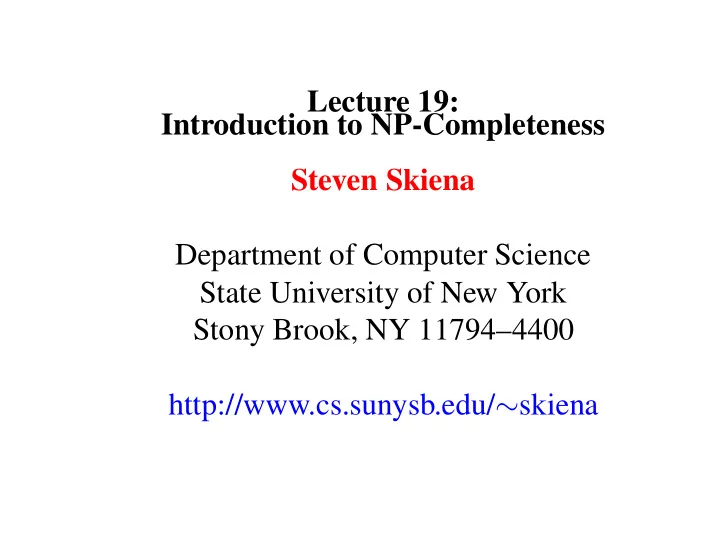

Lecture 19: Introduction to NP-Completeness Steven Skiena Department of Computer Science State University of New York Stony Brook, NY 11794–4400 http://www.cs.sunysb.edu/ ∼ skiena
Reporting to the Boss Suppose you fail to find a fast algorithm. What can you tell your boss? • “I guess I’m too dumb. . . ” (dangerous confession) • “There is no fast algorithm!” (lower bound proof) • “I can’t solve it, but no one else in the world can, either. . . ” (NP-completeness reduction)
The Theory of NP-Completeness Several times this semester we have encountered problems for which we couldn’t find efficient algorithms, such as the traveling salesman problem. We also couldn’t prove exponential-time lower bounds for these problems. By the early 1970s, literally hundreds of problems were stuck in this limbo. The theory of NP-Completeness, developed by Stephen Cook and Richard Karp, provided the tools to show that all of these problems were really the same problem.
The Main Idea Suppose I gave you the following algorithm to solve the bandersnatch problem: Bandersnatch( G ) Convert G to an instance of the Bo-billy problem Y . Call the subroutine Bo-billy on Y to solve this instance. Return the answer of Bo-billy( Y ) as the answer to G . Such a translation from instances of one type of problem to instances of another type such that answers are preserved is called a reduction .
What Does this Imply? Now suppose my reduction translates G to Y in O ( P ( n )) : 1. If my Bo-billy subroutine ran in O ( P ′ ( n )) I can solve the Bandersnatch problem in O ( P ( n ) + P ′ ( n ′ )) 2. If I know that Ω( P ′ ( n )) is a lower-bound to compute Bandersnatch, then Ω( P ′ ( n ) − P ( n ′ )) must be a lower- bound to compute Bo-billy. The second argument is the idea we use to prove problems hard!
What is a Problem? A problem is a general question, with parameters for the input and conditions on what is a satisfactory answer or solution. Example: The Traveling Salesman Problem: Given a weighted graph G , what tour { v 1 , v 2 , ..., v n } � n − 1 i =1 d [ v i , v i +1 ] + d [ v n , v 1 ] . minimizes
What is an Instance? An instance is a problem with the input parameters specified. TSP instance: d [ v 1 , d 2 ] = 10 , d [ v 1 , d 3 ] = 5 , d [ v 1 , d 4 ] = 9 , d [ v 2 , d 3 ] = 6 , d [ v 2 , d 4 ] = 9 , d [ v 3 , d 4 ] = 3 1 5 10 9 6 3 3 9 2 4 Solution: { v 1 , v 2 , v 3 , v 4 } cost= 27
Input Encodings Note that there are many possible ways to encode the input graph: adjacency matrices, edge lists, etc. All reasonable encodings will be within polynomial size of each other. The fact that we can ignore minor differences in encoding is important. We are concerned with the difference between algorithms which are polynomial and exponential in the size of the input.
Decision Problems A problem with answers restricted to yes and no is called a decision problem . Most interesting optimization problems can be phrased as decision problems which capture the essence of the computation. For convenience, from now on we will talk only about decision problems.
The Traveling Salesman Decision Problem Given a weighted graph G and integer k , does there exist a traveling salesman tour with cost ≤ k ? Using binary search and the decision version of the problem we can find the optimal TSP solution.
Reductions Reducing (tranforming) one algorithm problem A to another problem B is an argument that if you can figure out how to solve B then you can solve A . We showed that many algorithm problems are reducible to sorting (e.g. element uniqueness, mode, etc.). A computer scientist and an engineer wanted some tea. . .
Satisfiability Consider the following logic problem: Instance: A set V of variables and a set of clauses C over V . Question: Does there exist a satisfying truth assignment for C ? Example 1: V = v 1 , v 2 and C = {{ v 1 , v 2 } , { v 1 , v 2 }} A clause is satisfied when at least one literal in it is TRUE. C is satisfied when v 1 = v 2 = TRUE.
Not Satisfiable Example 2: V = v 1 , v 2 , C = {{ v 1 , v 2 } , { v 1 , v 2 } , { v 1 }} Although you try, and you try, and you try and you try, you can get no satisfaction. There is no satisfying assigment since v 1 must be FALSE (third clause), so v 2 must be FALSE (second clause), but then the first clause is unsatisfiable!
Recommend
More recommend